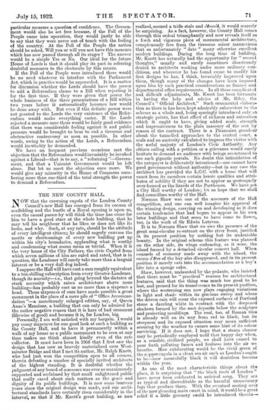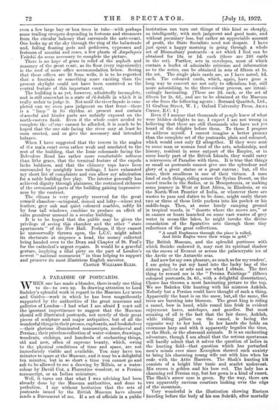THE NEW COUNTY HALL.
NOW that the crowning cupola of the London County Council's new Hall has emerged from its cocoon of scaffolding and the bustle of a Royal opening is upon us, even the casual passer-by will think the time has come for him to have a good stare at the whole building, that he may tell his neighbour that he likes or does not like its looks, and why. Such, at any rate, should be the attitude of every intelligent citizen; he should eagerly canvass the merits or shortcomings of every new building put up within his city's boundaries, applauding what is worthy and condemning what seems mean or trivial. When it is the very home of the City Fathers, the civic Capitol from which seven millions of him are ruled and rated, that is in question, the Londoner will surely take more than a languid interest or be a very dull dog indeed.
I suppose the Hall will have cost a sum roughly equivalent to a ten-shilling subscription from every Greater-Londoner, though its amenity-i.e., that going beyond the dictates of stark necessity which raises architecture above mere building—has probably cost us no more than a sixpence a head. These sixpences of ours have made possible a great monument in the place of a mere pile of " Office Accommo- dation "—a monstrously enlarged edition, say, of Queen Anne's Mansions, a building that can only be admired for the rather negative reason that it is bare of bad ornament (likewise of good) and because it is, for London, big.
Personally, I am well satisfied with my bargain. I would pay many sixpences for one good look at such a building as the County Hall, and to have it permanently within a walk of my house as a public monument to be seen at any time makes me think almost kindly even of the rate collector. It must have been in 1908 that I first saw the design that has now so bravely materialized over West- minster Bridge and that I met its author, Mr. Ralph Knott, who had just won the competition open to all comers, therein defeating a number of specially invited architects of the highest standing. It is doubtful whether the judgment of any board of assessors was ever so unanimously supported and acclaimed by that small enlightened public that really cared about such matters as the grace and dignity of its public buildings. It is now some fourteen years since the original design was made, and our archi- tectural standards have certainly risen considerably in the interval, so that if Mr. Knott's great building, as now realized, seemed a trifle stale and dimodef, it would scarcely be surprising. As a fact, however, the County Hall comes through this ordeal triumphantly and now reveals itself as a fresh and vigorous piece of monumental architecture, conspicuously free from the tiresome minor mannerisms that so unfortunately " date " many otherwise excellent modern buildings. During the long time of building, Mr. Knott has naturally had the opportunity for " second thoughts," usually and surely sometimes disastrously denied to architects working under more ordinary con- ditions, and wherever he has found cause to modify his first designs he has, I think, invariably improved upon them, though many of the changes have been imposed upon him by such practical considerations as finance and departmental office requirements. In all these complicated and difficult adjustments, Mr. Knott has been fortunate in having the help and advice of Mr. Riley, the Council's " Official Architect." Such ornamental elabora- tion as there is has been kept admirably subservient to the scheme as a whole and, being sparingly introduced only at strategic points, has that effect of richness and animation which it ought to have, giving added scale, strength and impressiveness to the plain masonry of the rest by reason of the contrast. There is a Piranesian grandeur` about the tunnelled approaches to the central court, a scale and an austerity calculated to impress the visitor with the awful majesty of London's Civic Authority. Any citizen calling with a petition or a grievance would surely hesitate to demand an audience with beings accustomed te use such gigantic portals. No doubt this intimidation of the ratepayer is deliberately intentioned—one cannot have good government without authority—but in any case the architect has provided the L.C.C. with a home that will exact from its members certain heroic qualities and attri- butes of nobility if they are not to appear as grotesquely over-housed as the lizards of the Parthenon. We have got a City Hall worthy of London ; let us hope that we shall find councillors worthy of the Hall.
Norman Shaw was one of the assessors of the Hall competition, and one can well imagine his approval of the winning design, carrying on and developing as it does certain tendencies that had begun to appear in his own later buildings and that seem to have come to flower, too, in the work of Sir Edwin Lutyens.
It is to Norman Shaw that we owe the presence of the great semi-circular re-entrant on the river front, justified in its present position by nothing but its undeniable beauty. In the original scheme this feature was planned on the other side, its wings embracing, as it were, the island formed by a detached circular concert hall. When counsels of economy made away with the island, the raison d'Etre of the bay also disappeared, and in its present position it merely eats into the accommodation as a boy's bite into a sponge cake. Shaw, however, undaunted by the pedants, who insisted that there must be " practical " reasons for architectural features, said that the thing was much too good to be lost, and pressed for its transference to its present position, where the westerning sun now plays engaging variations in light and shade within its gracious sweep and where the driven rain will scour the exposed surfaces of Portland stone a dazzling white in contrast with the deepened shadows formed by the soot deposits below the sculpture and projecting mouldings. The roof, too, of Roman tiles is already well on its way from red to black, but its steepness and its exposed situation may mean sufficient i scouring by the weather to ensure some hint of its colour surviving. If it does not, I hope that a steam cleaner may be periodically employed until that happy day when, as a sensible, civilized people, we shall have ceased to pour forth polluting fumes and foulness into the air we breathe. How exhilarating would be the vivid green of the copper cupola in a clean sea air such as London's ought to be—how mournfully black it will doubtless become within the year.
As one of the most characteristic things about the place, it is surprising that " the black roofs of London" have never been celebrated in satirical song. They are as typical and discreditable as the harmful unnecessary fogs that produce them. With the eventual sooting over of the now gleaming main court in mind, it would be a great relief if a little greenery could be introduced therein--- even a few large bay or box trees in tubs—with perhaps some trailing creepers depending in festoons and streamers from the circular balcony that surrounds the ante-court. One looks up at the sky through the ring of the balustrade and, failing floating gods and goddesses, cypresses and festoons of amorini and roses, a few plants of Ampelopsis Veitehii do seem necessary to complete the picture.
There is no hope of grass in relief of the asphalt and masonry of the great ccurt, as its floor (very ingeniously) is the roof of more office accommodation below. Seeing that these offices are lit from wells, it is to be regretted that a fountain or something more exciting than the present skylight could not have been contrived as the central feature of this important court. The building is as yet, however, admittedly incomplete, and is still somewhat in a state of deshabille in which it is really unfair' to judge it. Not until the river façade is com- pleted can we even pass judgment on that front—there is a " limp " in its rhythm at present and certain shameful and hinder parts are unfairly exposed on the north-eastern flank. Even if the whole court needed to complete the Eclem3 cannot be afforded, it is much to be hoped that the one side facing the river may at least be soon erected, and se give the necessary and intended balance.
When I have suggested that the towers in the angles of the ma=n court seem rather weak and unrelated to the rest of the building, that the Ionic colonnade facing the Belvedere Road has rather more comfortable softness than lithe grace, that the terminal feature of the cupola lacks boldness, and that the chimney tops have been surrounded by unsightly iron railings, I have exhausted my short list of complaints and can allow my admiration or a noble building free play. The interior generally has achieved dignity through plainness, the restrained richness of the ceremonial parts of the building gaining impressive- ness by the contrast.
The climax is very properly reserved for the great council chamber—octagonal, domed and lofty—where red leather, grey oak and quiet coloured marbles, softly lit by four tall windows, combine to produce an effect of calm grandeur unusual in a secular building. It is to be hoped that the public may be given the privilege of seeing this chamber and the other " state apartments " of the New Hall. Perhaps, if they cannot be unreservedly thrown open, the L.C.C. might admit its electorate at sixpence a head, the money collected being handed over to the Dean and Chapter of St. Paul's for the cathedral's urgent repairs. It would be a graceful gesture, implying a filial piety on the part of London's newest " national monument " in thus helping to support and preserve its most illustrious English ancestor. CLOT:JOE{ WILLIAMS-ELLIS.



































 Previous page
Previous page